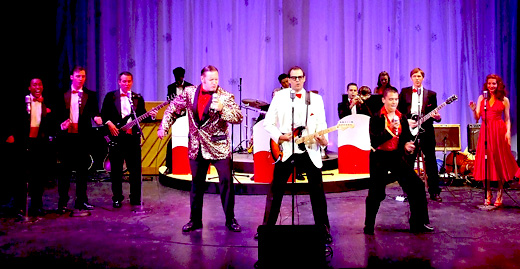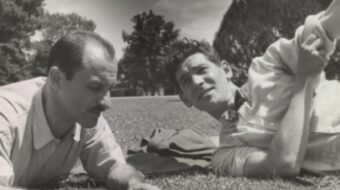
Buddy, The Buddy Holly Story is a highly entertaining musical about the meteoric rise – and, alas, fall — of the 1950s rock ‘n’ roll icon. Todd Meredith does a bravura acting job, singing and guitar playing as the Texan with the horn rimmed glasses who rose to the top of the charts with classics such as That’ll Be the Day and Peggy Sue. Anybody who loves 1950s rock music will enjoy this crowd-pleasing dramatization. P&G Designs’ sets, with Howdy Doody and Lone Ranger pop culture motifs, evoke a wistful ’50s ambiance.
London-born playwright Alan Janes’ 1989 musical is long on Holly’s music but short on the drama. Act I depicts the struggles of the Lubbock lad and the Crickets (Logan Farine as drummer Jerry Allison, and Bill Morey as the upstaging, acrobatic bass player Joe B. Mauldin), who counter Texas’ prevailing Country Western grain with their rockers’ vibe. Their rockabilly sensibility and driving rhythms propel the group onto the hit parade. Soon they outgrow their Lone Star milieu and Norman Petty’s (Nathan Yates Douglass) New Mexico recording studio, and they are New York bound.
The band’s foray to the Big Apple helps to explain Buddy’s departure from Country and Lubbock. These Texans get it into their noggins to perform at the Apollo Theater. Their appearance at the renowned Harlem palace of African American culture is a seminal cross-cultural experience. Not only for the musicians but for the Black theatergoers as well (we the audience become that Harlem house!) Look for James S. Patton as a hilarious Apollo emcee and piano player. At one point in the play some cracker remarks that the band is playing “colored music” and Buddy responds as if to ask, “And your point is?”
Although Buddy’s songs are full of yearnings for love he has no romantic interests in the first act. However, in Act II Buddy meets, falls in love with, and marries Maria Elena (Jenny Stodd), a Manhattan music industry receptionist from Puerto Rico, an interracial marriage not only infrequent, but frowned upon in America — and in the Alamo state.
Buddy comes across as one of those rare individuals with nary a racist bone in his body. He embraces Black music and audiences, and falls head over heels for a Puerto Rican woman he plans to have a baby with. He seems to be so full of love that there’s no room for bigotry and hatred — possibly a major source of Holly’s loving lyrics and sound.
In the second act Buddy and the Crickets have differences of opinion that seem to emerge from nowhere, but Janes never develops this conflict. Never mind, the onstage rockers have yet another hit to belt out. The second half of Act II is essentially a reenactment of Buddy’s final live performance with Ritchie Valens (the ebullient, kinetic Emilio Ramos lights up the stage) and the Big Bopper (a delightfully daffy Mike Brennan) at the Surf Ballroom in Clear Lake, Iowa.
Clashing with capitalist Petty who refuses to pay Buddy (and apparently lives up to his name), with Maria Elena expecting, Buddy is forced out onto the road during winter weather in order to sing for his supper. Talk about class struggle! Knowing what’s about to befall the characters may cast a shadow for some viewers, but aficionados of vintage rock of the era will enjoy themselves as the show devolves into more or less a gig.
During the Clear Lake grand finale, Buddy plays post-Cricket songs, including “It Doesn’t Matter Anymore” and “Raining In My Heart,” showing the path his music was moving on, with deeper, more complex orchestration. If not for the cruel intercession of fate, who knows where Holly’s richer, fuller sound would have gone? What befell the pregnant Maria Elena is never mentioned [Maria Elena: My Life with Buddy, Interview by Don McLean].
Janes finesses “the day the music died” so as not to ruin the good vibes. Instead, this play with a large cast deftly directed by Steve Steiner leaves us with proverbial “Words of Love” and a nostalgic, upbeat rock ‘n’ roll concert — a day the music lived.
Buddy, The Buddy Holly Story plays Wednesdays through Fridays at 7:30 pm, Saturdays at 2:00 and 7:30 pm, and Sundays at 1:00 and 5:30 pm through August 10 at the Laguna Playhouse, 606 Laguna Canyon Road, Laguna Beach, CA 92651. (Note: An additional August 7 performance at 2:00 pm, but no 5:30 pm show on August 10.) For more info: (949) 497-ARTS; www.LagunaPlayhouse.com.
Photo: Cast photo from Laguna Playhouse.










